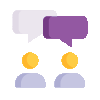The /sh/ sound is made by putting the teeth together and bringing the corners of the lips towards the middle, so the lips pucker like a kiss. The middle of the tongue comes up only slightly and barely touches the corners of the top teeth without touching the roof of the mouth. The front of the tongue dips down a tiny bit, but does not touch anything else in the mouth. The /sh/ sound is an unvoiced sound, which means what we hear when we make the sound comes only from the passage of air through the mouth and not from the vibration of vocal cords.
The normal range for children to develop this sound is between three and a half and seven years old. Often, children will be able to say this sound in isolation, but may have trouble using it regularly in words and conversations. If your child still has trouble either pronouncing or regularly using the /sh/ sound through seven years old, it is highly recommended that you seek the help of a licensed speech-language pathologist. The sooner you are able to identify and treat a small speech issue, the easier it will be to fix.
Whether your child is just learning to speak or working on specific trouble areas, practicing articulation with your child is a great way to spend time with your child and stimulate his or her speech development. Here are some tried-and-true tips from children’s speech therapists for the /sh/ sound:
- Verbal Cues
When practicing a single sound with your child, it is important to repeat the sound clearly and slowly by itself, so your child understands what you are focusing on. This also gives a good example of the sound for him to imitate. Begin with “/sh/, /sh/, /sh/” and encourage your child to repeat the sound as well. If your little one has trouble, try having them start with saying the long /e/ sound and coach them into transforming it into the /sh/ sound. Ask your child to say the long /e/ sound as a whisper, and then to pull the corners of their mouth together into a kiss shape. This should result in the /sh/ sound. After your child can successfully make and use the /sh/ sound by itself, practice with syllables, small words, and eventually sentences.
- Visual Cues
Your little ones are likely already very familiar with the /sh/ sound in the form of “shushing”. When a child sees someone with puckered lips with their finger resting on them, they usually recognize the symbol for being quiet. Use this familiarity to help teach cue your child to make the /sh/ sound. Put your own finger to your lips in the “shhh” symbol, and encourage your child to “shush” you back. Gradually, your child will become more comfortable with making the /sh/ sound and will be able to use it in syllables and words as well.
- Tactile Cues
When the /sh/ sound is pronounced correctly, a small stream of air escapes from between the lips. Have your little one put her hand in front of your lips as you make the sound to feel the air. Then, ask her to put her hand in front of her own mouth while she makes the sound. Can she feel the air? This is a sign she can use to tell if she is making the sound right.
- Awesome /sh/ Activity
Ask your child to help you instate “quiet time” around the house before naptime or bed time. Walk around with your child “shh-ing” everything: “shhh, door! Shhh, couch! It’s naptime!” This is a silly way to work in fun practice that kids love. In just a few minutes of “shh-ing” the house, your child will get to say the /sh/ sound tons of times!












